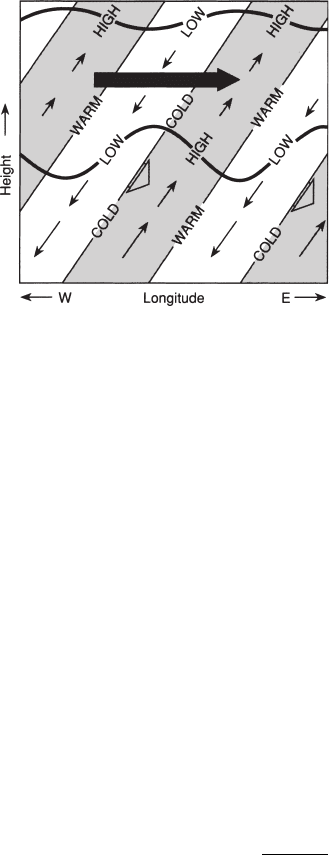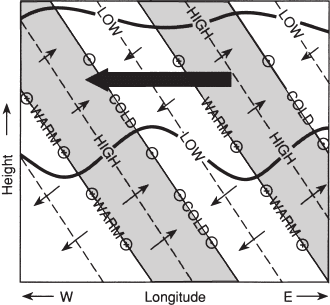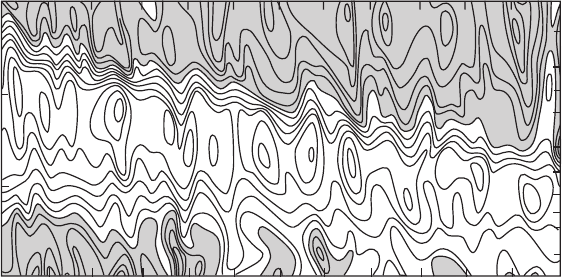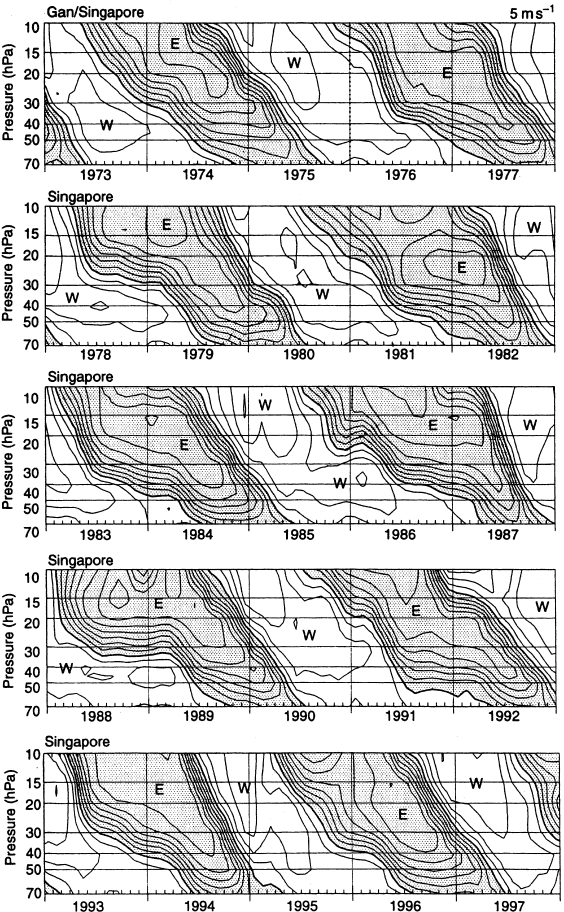Holton, James R. An Introduction to Dynamic Meteorology
Подождите немного. Документ загружается.


January 27, 2004 15:55 Elsevier/AID aid
428 12 middle atmosphere dynamics
For linear planetary waves satisfying the quasigeostrophic equations, it can be
shown that
F =
0,c
gy
,c
gz
A (12.27)
so that the EP flux is given by the wave activity times the group velocity in
the meridional (y, z) plane. It is the flux of wave activity—not the flux of wave
energy—that is fundamental for wave, mean-flow interaction.
Equation (12.25) shows that if dissipation and transience vanish, the EP flux
divergence must vanish. Substitution into (12.1) then gives the nonacceleration
theorem, which states that there is no wave-driven mean-flow acceleration for
steady
(
∂A/∂t = 0
)
and conservative (D = 0) waves. The EP flux divergence,
which must be nonzero for wave-induced forcing, is dependent on wave transience
and dissipation.
In sudden stratospheric warmingsthe planetary wave amplitudes increase rapidly
in time. During the Northern Hemisphere winter, quasi-stationary planetary waves
of zonal wave numbers 1 and 2 are produced in the troposphere by orographic
forcing. These waves propagate vertically into the stratosphere, implying a local
increase in the wave activity. Thus, ∂A/∂t > 0, implying from (12.25) that, for
quasi-conservative flow, the flux of quasi-geostrophic potential vorticityis negative
and that the Eliassen–Palm flux field is convergent:
ρ
0
v
q
=∇· F < 0 (12.28)
Usually D<0 also, so dissipation and wave growth both produce a convergent
EP flux (i.e., an equatorward potential vorticity flux).
According to the transformed Eulerian-mean zonal momentum equation (12.1),
EP flux convergence leads to a deceleration of the zonal-mean zonal wind, partially
offset by the Coriolis torquef
v
∗
. As a result, the polar night jet weakens, allowing
even more waves to propagate into the stratosphere. At some point, the mean
zonal wind changes sign so that a critical layer is formed. Stationary linear waves
can no longer propagate beyond the level where this occurs, and strong EP flux
convergence and even faster easterly acceleration then occurs below the critical
layer.
Figure 12.11a illustrates the deceleration of the zonal-mean wind due to the
Eliassen–Palm flux convergence caused by upward propagation of transient plan-
etary wave activity. Note that the deceleration is spread out over a broader range in
height than the eddy forcing. This reflects the elliptical nature of the equation for
mean zonal-wind acceleration that can be derived from the transformed Eulerian
mean equations. Fig. 12.11b shows the TEM residual meridional circulation and
the pattern of temperature perturbation associated with the zonal wind decelera-
tion. The thermal-wind relation implies that a deceleration of the polar night jet
leads to a warming in the polar stratosphere and a cooling in the equatorial strato-
sphere, with a compensating warming in the polar mesosphere and cooling in the

January 27, 2004 15:55 Elsevier/AID aid
12.5 waves in the equatorial stratosphere 429
Fig. 12.11 Schematic of transient wave, mean–flow interactions occurring during a stratospheric
warming. (a) Height profiles of EP flux (dashed), EP flux divergence (heavy line), and
mean zonal flow acceleration (thin line); z
0
is the height reached by the leading edge of
the wave packet at the time pictured. (b) Latitude–height cross section showing region
where the EP flux is convergent (hatched), contours of induced zonal acceleration (thin
lines), and induced residual circulation (arrows). Regions of warming (W) and cooling
(C) are also shown. (After Andrews et al., 1987.)
equatorial mesosphere. Eventually, as more of the flow becomes easterly, waves
can no longer propagate vertically. The wave-induced residual circulation then
decreases, and radiative cooling processes are able to slowly reestablish the nor-
mal cold polar temperatures. Thermal-wind balance then implies that the normal
westerly polar vortex is also reestablished.
In some cases the wave amplification may be large enough to produce a polar
warming, but insufficient to lead to reversal of the mean zonal wind in the polar
region. Such “minor warmings” occur every winter and are generally followed by
a quick return to the normal winter circulation. A “major warming” in which the
mean zonal flow reverses at least as low as the 30-hPa level in the polar region
seems to occur only about once every couple of years. If the major warming occurs
sufficiently late in the winter, the westerly polar vortex may not be restored at all
before the normal seasonal circulation reversal.
12.5 WAVES IN THE EQUATORIAL STRATOSPHERE
Section 11.4 discussed equatorially trapped waves in the context of shallow water
theory. Undersomeconditions,however,equatorial waves (both gravityandRossby
types) may propagate vertically, and the shallow water model must be replaced
by a continuously stratified atmosphere in order to examine the vertical structure.
January 27, 2004 15:55 Elsevier/AID aid
430 12 middle atmosphere dynamics
It turns out that vertically propagating equatorial waves share a number of physical
properties with ordinary gravity modes. Section 7.5 discussed vertically propagat-
ing gravity waves in the presence of rotation for a simple situation in which the
Coriolis parameter was assumed to be constant and the waves were assumed to be
sinusoidal in both x and y. We found that such inertia–gravity waves can propagate
vertically only when the wave frequency satisfies the inequality f<ν<N. Thus,
at middle latitudes, waves with periods in the range of several days are generally
vertically trapped (i.e., they are not able to propagate significantly into the strato-
sphere). As the equator is approached, however, the decreasing Coriolis frequency
should allow vertical propagation to occur for lower frequency waves. Thus, in
the equatorial region there is the possibility for existence of long-period vertically
propagating internal gravity waves.
As in Section 11.4 we consider linearized perturbations on an equatorial βplane.
The linearized equations of motion, continuity equation, and first law of thermo-
dynamics can then be expressed in log-pressure coordinates as
∂u
/∂t − βyv
=−∂
/∂x (12.29)
∂v
/∂t + βyu
=−∂
/∂y (12.30)
∂u
/∂x + ∂v
/∂y + ρ
−1
0
∂
ρ
0
w
/∂z = 0 (12.31)
∂
2
/∂t∂z + w
N
2
= 0 (12.32)
We again assume that the perturbations are zonally propagating waves, but we
now assume that they also propagate vertically with vertical wave number m. Due
to the basic state density stratification, there will also be an amplitude growth in
height proportional to ρ
−1/2
0
. Thus, the x,y,z, and t dependencies can be separated
as
u
v
w
= e
z/2H
ˆu
(
y
)
ˆv
(
y
)
ˆw
(
y
)
ˆ
(
y
)
exp
[
i
(
kx + mz − νt
)
]
(12.33)
Substituting from (12.33) into (12.29)–(12.32) yields a set of ordinary differen-
tial equations for the meridional structure:
−iν ˆu −βy ˆv =−ik
ˆ
(12.34)
−iν ˆv + βy ˆu =−∂
ˆ
/∂y (12.35)
ik ˆu + ∂ ˆv/∂y
+ i
(
m + i/2H
)
ˆw = 0 (12.36)
ν
(
m − i/2H
)
ˆ
+ˆwN
2
= 0 (12.37)
January 27, 2004 15:55 Elsevier/AID aid
12.5 waves in the equatorial stratosphere 431
12.5.1 Vertically Propagating Kelvin Waves
For Kelvin waves the aforementioned perturbation equations can be simplified
considerably. Setting ˆv = 0 and eliminating ˆw between (12.36) and (12.37), we
obtain
−iν ˆu =−ik
ˆ
(12.38)
βy ˆu =−∂
ˆ
/∂y (12.39)
−ν
m
2
+ 1/4H
2
ˆ
+ˆukN
2
= 0 (12.40)
Equation (12.38) can be used to eliminate in (12.39) and (12.40). This yields
two independent equations that the field of ˆu must satisfy. The first of these deter-
mines the meridional distribution of ˆu and is identical to (11.47). The second is
simply the dispersion equation
c
2
m
2
+ 1/4H
2
− N
2
= 0 (12.41)
where, as in Section 11.4, c
2
= (ν
2
/k
2
).
If we assume that m
2
1/4H
2
, as is true for most observed stratospheric
Kelvin waves, (12.41) reduces to the dispersion relationship for internal gravity
waves (7.44) in the hydrostatic limit (|k||m|). For waves in the stratosphere
that are forced by disturbances in the troposphere, the energy propagation (i.e.,
the group velocity) must have an upward component. Therefore, according to the
arguments of Section 7.4, the phase velocity must have a downward component.
We showed in Section 11.4 that Kelvin waves must propagate eastward (c > 0) if
they are to be trapped equatorially. However, eastward phase propagation requires
m<0 for downward phase propagation. Thus, the vertically propagating Kelvin
wave has phase lines that tilt eastward with height as shown in Fig. 12.12.
12.5.2 Vertically Propagating Rossby–Gravity Waves
For all other equatorial modes, (12.34)–(12.37) can be combined in a manner
exactlyanalogous to that described for the shallowwater equations in Section 11.4.1.
The resulting meridional structure equation is identical to (11.38) if we again
assume that m
2
1/4H
2
and set
gh
e
= N
2
/m
2
For the n = 0 mode the dispersion relation (11.41) then implies that
|
m
|
= Nν
−2
(
β + νk
)
(12.42)

January 27, 2004 15:55 Elsevier/AID aid
432 12 middle atmosphere dynamics
Fig. 12.12 Longitude–height section along the equator showing pressure, temperature, and wind
perturbations for a thermally damped Kelvin wave. Heavy wavy lines indicate material
lines; short blunt arrows show phase propagation. Areas of high pressure are shaded.
Length of the small thin arrowsis proportional to the waveamplitude, which decreases with
height due to damping. The large shaded arrow indicates the net mean flow acceleration
due to the wave stress divergence.
When β = 0 we again recover the dispersion relationship for hydrostatic inter-
nal gravity waves. The role of the β effect in (12.42) is to break the symmetry
between eastward (ν > 0) and westward (ν < 0) propagating waves. Eastward
propagating modes have shorter vertical wavelengths than westward propagating
modes. Vertically propagating n = 0 modes can exist only for c = ν/k > −β/k
2
.
Because k = s/a, where s is the number of wavelengths around a latitude circle,
this condition implies that for ν<0 solutions exist only for frequencies satisfying
the inequality
|
ν
|
< 2/s (12.43)
For frequencies that do not satisfy (12.43), the wave amplitude will not decay away
from the equator and it is not possible to satisfy boundary conditions at the pole.
After some algebraic manipulation, the meridional structure of the horizontal
velocity and geopotential perturbations for the n = 0 mode can be expressed as
ˆu
ˆv
ˆ
= v
0
i
|
m
|
N
−1
νy
1
iνy
exp
−
β
|
m
|
y
2
2N
(12.44)
The westward propagating n = 0 mode is generally referred to as the Rossby–
gravity mode.
2
For upward energy propagation this mode must have downward
2
Some authors use this term to describe both eastward and westward n = 0 waves.

January 27, 2004 15:55 Elsevier/AID aid
12.5 waves in the equatorial stratosphere 433
Fig. 12.13 Longitude–height section along a latitude circle north of the equator showing pressure,
temperature, and wind perturbations for a thermally damped Rossby–gravity wave.Areas
of high pressure are shaded. Small arrows indicate zonal and vertical wind perturbations
with length proportional to the wave amplitude. Meridional wind perturbations are shown
by arrows pointed into the page (northward) and out of the page (southward). The large
shaded arrow indicates the net mean flow acceleration due to the wave stress divergence.
phase propagation (m < 0) just like an ordinary westward propagating internal
gravity wave. The resulting wave structure in the x, z plane at a latitude north of
the equator is shown in Fig. 12.13. Of particular interest is the fact that poleward
moving air has positive temperature perturbations and vice versa so that the eddy
heat flux contribution to the vertical EP flux is positive.
12.5.3 Observed Equatorial Waves
Both Kelvin and Rossby–gravity modes have been identified in observational data
from the equatorial stratosphere. The observed stratospheric Kelvin waves are
primarily of zonal wave number s = 1 and have periods in the range of 12–20 d.
An example of zonal wind oscillations caused by the passage of Kelvin waves at a
station near the equator is shown in the form of a time–height section in Fig. 12.14.
During the observational period shown in Fig. 12.14, the westerly phase of the
quasi-biennial oscillation (see Section 12.6) is descending so that at each level
there is a general increase in the mean zonal wind with increasing time. However,
superposed on this secular trend is a large fluctuating component with a period
between speed maxima of about 12 days and a vertical wavelength (computed
from the tilt of the oscillations with height) of about 10–12 km. Observations of the
temperature field for the same period reveal that the temperature oscillation leads
the zonal wind oscillation by 1/4 cycle (i.e., maximum temperature occurs prior
to maximum westerlies), which is just the phase relationship required for upward
propagating Kelvin waves (see Fig. 12.12). Additional observations from other

January 27, 2004 15:55 Elsevier/AID aid
434 12 middle atmosphere dynamics
10
15
20
25
30
40
50
60
70
80
100
125
Pressure (hPa)
30
25
20
15
11020
31 10 10 20 31 10 20 3120 31
MAY JUN JUL AUG
1963
Height (km)
E
E
E
E
E
E
W
W
W
W
W
W
Fig. 12.14 Time–height section of zonal wind at Canton Island (3
◦
S). Isotachs at intervals of 5 m s
−1
.
Westerlies are shaded. (Courtesy of J. M. Wallace and V. E. Kousky.)
stations indicate that these oscillations do propagate eastward at the theoretically
predicted speed. Therefore, there can be little doubt that the observed oscillations
are Kelvin waves.
The existence of the Rossby–gravity mode has been confirmed in observational
data from the stratosphere in the equatorial Pacific. This mode is identified most
easily in the meridional wind component, as v
is a maximum at the equator
for the Rossby–gravity mode. The observed Rossby–gravity waves have s = 4,
vertical wavelengths in the range of 6–12 km, and a period range of 4–5 d. Kelvin
and Rossby–gravity waves each have significant amplitude only within about 20
◦
latitude of the equator.
A more complete comparison of observed and theoretical properties of the
Kelvin and Rossby–gravity modes is presented in Table 12.1. In comparing theory
and observation, it must be recalled that it is the frequency relative to the mean
flow, not relative to the ground, that is dynamically relevant.
It appears that Kelvin and Rossby–gravity waves are excited by oscillations in
the large-scale convective heating pattern in the equatorial troposphere. Although
these waves do not contain much energy compared to typical tropospheric weather
disturbances, they are the predominant disturbances of the equatorial stratosphere,
and through their vertical energy and momentum transport play a crucial role in
the general circulation of the stratosphere. In addition to the stratospheric modes
considered here, there are higher speed Kelvin and Rossby–gravity modes, which
are important in the upper stratosphere and mesosphere. There is also a broad spec-
trum of equatorial gravity waves, which appears to be important for the momentum
balance of the equatorial middle atmosphere.

January 27, 2004 15:55 Elsevier/AID aid
12.6 the quasi-biennial oscillation 435
Table 12.1 Characteristics of the Dominant Observed Planetary-Scale Waves in the Equatorial Lower
Stratosphere
a
Theoretical description Kelvin wave Rossby–gravity wave
Discovered by Wallace and Kousky Yanai and Maruyama
(1968) (1966)
Period (ground-based) 2πω
−1
15 days 4–5 days
Zonal wave number s = ka cos φ 1–2 4
Vertical wavelength 2 π m
−1
6–10 km 4–8 km
Average phase speed relative to +25 m s
−1
–23ms
−1
ground
Observed when mean zonal flow Easterly Westerly
is (maximum ≈−25ms
−1
) (maximum ≈+7ms
−1
)
Average phase speed relative to
maximum zonal flow +50 m s
−1
–30ms
−1
Approximate observed amplitudes
u
8ms
−1
2–3ms
−1
v
0 2–3ms
−1
T
2–3 K 1 K
Approximate inferred amplitudes
/g 30 m 4 m
w
1.5 × 10
−3
ms
−1
1.5 × 10
−3
ms
−1
Approximate meridional scales
2N
β|m|
1/2
1300–1700 km 1000–1500 km
a
(After Andrews et al., 1987).
12.6 THE QUASI-BIENNIAL OSCILLATION
The search for periodic oscillations in the atmosphere has a long history. Aside,
however, from the externally forced diurnal and annual components and their har-
monics, no compelling evidence exists for truly periodic atmospheric oscillations.
The phenomenon that perhaps comes closest to exhibiting periodic behavior not
associated with a periodic forcing function is the quasi-biennial oscillation (QBO)
in the mean zonal winds of the equatorial stratosphere. This oscillation has the
following observed features.
1. Zonally symmetric easterly and westerly wind regimes alternate regularly
with periods varying from about 24 to 30 months.
2. Successive regimes first appear above 30 km, but propagate downward at a
rate of 1 km month
−1
.
3. The downward propagation occurs without loss of amplitude between 30
and 23 km, but there is rapid attenuation below 23 km.
4. The oscillation is symmetric about the equator with a maximum amplitude
of about 20 m s
−1
, and an approximately Gaussian distribution in latitude with a
half-width of about 12
◦
.

January 27, 2004 15:55 Elsevier/AID aid
436 12 middle atmosphere dynamics
This oscillation is best depicted by means of a time–height section of the zonal
wind speed at the equator as shown in Fig. 12.15. It is apparent from Fig. 12.15
that the vertical shear of the wind is quite strong at the level where one regime
is replacing the other. Because the QBO is zonally symmetric and causes only
very small mean meridional and vertical motions, the QBO mean zonal wind and
temperature fields satisfy the thermal wind balance equation. For the equatorial
β-plane this has the form [compare (10.13)]
βy∂
u/∂z =−RH
−1
∂T/∂y
For equatorial symmetry ∂
T/∂y = 0aty = 0, and by L’Hopital’s rule thermal
wind balance at the equator has the form
∂
u/∂z =−R
(
Hβ
)
−1
∂
2
T/∂y
2
(12.45)
Equation (12.45) can be used to estimate the magnitude of the QBO tempera-
ture perturbation at the equator. The observed magnitude of vertical shear of the
mean zonal wind at the equator is ∼ 5ms
−1
km
−1
, and the meridional scale is
∼ 1200 km, from which (12.45) shows that the temperature perturbation has an
amplitude ∼ 3 K at the equator. Because the second derivative of temperature has
the opposite sign to that of the temperature at the equator, the westerly and easterly
shear zones have warm and cold equatorial temperature anomalies, respectively.
The main factors that a theoretical model of the QBO must explain are the
approximate biennial periodicity, the downwardpropagation without loss of ampli-
tude, and the occurrence of zonally symmetric westerlies at the equator. Because
a zonal ring of air in westerly motion at the equator has an angular momentum
per unit mass greater than that of the earth, no plausible zonally symmetric advec-
tion process could account for the westerly phase of the oscillation. Therefore,
there must be a vertical transfer of momentum by eddies to produce the westerly
accelerations in the downward-propagating shear zone of the QBO.
Observational and theoretical studies have confirmed that vertically propagating
equatorial Kelvin and Rossby–gravity waves provide a significant fraction of the
zonal momentum sources necessary to drive the QBO. From Fig. 12.12 it is clear
that Kelvin waves with upward energy propagation transfer westerly momentum
upward (i.e., u
and w
are positively correlated so that u
w
> 0). Thus, the Kelvin
waves can provide a source of westerly momentum for the QBO.
Vertical momentum transfer by the Rossby–gravity mode requires special con-
sideration. Examination of Fig. 12.13 shows that
u
w
> 0 also for the Rossby–
gravity mode. The total effect of this wave on the mean flow cannot be ascertained
from the vertical momentum flux alone, but rather the complete vertical EP flux
must be considered. This mode has a strong poleward heat flux (
v
T
> 0), which

January 27, 2004 15:55 Elsevier/AID aid
12.6 the quasi-biennial oscillation 437
Fig. 12.15 Time–height section of departure of monthly mean zonal winds (m s
−1
) for each month
from the long-term average for that month at equatorial stations. Note the alternating
downward propagating westerly (W) and easterly (E) regimes. (After Dunkerton, 2003.
Data provided by B. Naujokat.)
